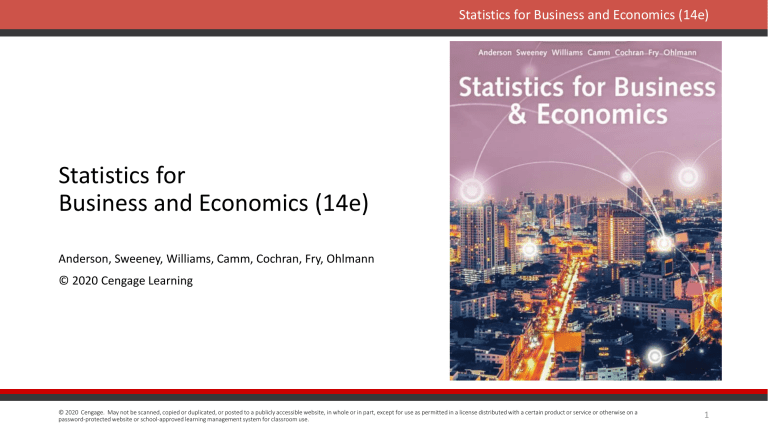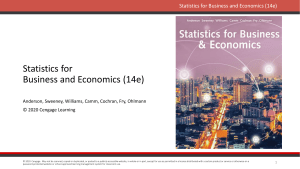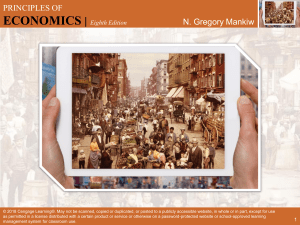
Statistics for Business and Economics (14e) Statistics for Business and Economics (14e) Anderson, Sweeney, Williams, Camm, Cochran, Fry, Ohlmann © 2020 Cengage Learning © 2020 Cengage. May not be scanned, copied or duplicated, or posted to a publicly accessible website, in whole or in part, except for use as permitted in a license distributed with a certain product or service or otherwise on a password-protected website or school-approved learning management system for classroom use. 1 Statistics for Business and Economics (14e) A Summary of Forms for Null and Alternative Hypotheses About a Population Proportion • The equality part of the hypotheses always appears in the null hypothesis. • In general, a hypothesis test about the value of a population proportion 𝑝 must take one of the following three forms (where 𝑝0 is the hypothesized value of the population proportion). © 2020 Cengage. May not be scanned, copied or duplicated, or posted to a publicly accessible website, in whole or in part, except for use as permitted in a license distributed with a certain product or service or otherwise on a password-protected website or school-approved learning management system for classroom use. 2 Statistics for Business and Economics (14e) Tests About a Population Proportion (1 of 2) Test Statistic: © 2020 Cengage. May not be scanned, copied or duplicated, or posted to a publicly accessible website, in whole or in part, except for use as permitted in a license distributed with a certain product or service or otherwise on a password-protected website or school-approved learning management system for classroom use. 3 Statistics for Business and Economics (14e) Tests About a Population Proportion (2 of 2) • Rejection Rule: p –Value Approach Reject H0 if p –value ≤ α • Rejection Rule: Critical Value Approach © 2020 Cengage. May not be scanned, copied or duplicated, or posted to a publicly accessible website, in whole or in part, except for use as permitted in a license distributed with a certain product or service or otherwise on a password-protected website or school-approved learning management system for classroom use. 4 Statistics for Business and Economics (14e) Two-Tailed Test About a Population Proportion (1 of 4) Example: National Safety Council (NSC) For a Christmas and New Year’s week, the National Safety Council estimated that 500 people would be killed and 25,000 injured on the nation’s roads. The NSC claimed that 50% of the accidents would be caused by drunk driving. A sample of 120 accidents showed that 67 were caused by drunk driving. Use these data to test the NSC’s claim with α = 0.05. © 2020 Cengage. May not be scanned, copied or duplicated, or posted to a publicly accessible website, in whole or in part, except for use as permitted in a license distributed with a certain product or service or otherwise on a password-protected website or school-approved learning management system for classroom use. 5 Statistics for Business and Economics (14e) Two-Tailed Test About a Population Proportion (2 of 4) © 2020 Cengage. May not be scanned, copied or duplicated, or posted to a publicly accessible website, in whole or in part, except for use as permitted in a license distributed with a certain product or service or otherwise on a password-protected website or school-approved learning management system for classroom use. 6 Statistics for Business and Economics (14e) Two-Tailed Test About a Population Proportion (3 of 4) p –Value Approach 4. Compute the p –value. For z = 1.28, the cumulative probability = 0.8997. p-value = 2(1 – 0.8997) = 0.2006. 5. Determine whether to reject H0. Because p-value = 0.2006 > α = 0.05, we cannot reject H0. We do not have convincing evidence that the true proportion of accidents that would be caused by drunk driving is different than 50%. © 2020 Cengage. May not be scanned, copied or duplicated, or posted to a publicly accessible website, in whole or in part, except for use as permitted in a license distributed with a certain product or service or otherwise on a password-protected website or school-approved learning management system for classroom use. 7 Statistics for Business and Economics (14e) Two-Tailed Test About a Population Proportion (4 of 4) Critical Value Approach 4. Determine the critical value and the rejection rule. 5. Determine whether to reject H0. Because 1.278 is not less than −1.96 and is not greater than 1.96, we cannot reject H0. We do not have convincing evidence that the true proportion of accidents that would be caused by drunk driving is different than 50%. © 2020 Cengage. May not be scanned, copied or duplicated, or posted to a publicly accessible website, in whole or in part, except for use as permitted in a license distributed with a certain product or service or otherwise on a password-protected website or school-approved learning management system for classroom use. 8







